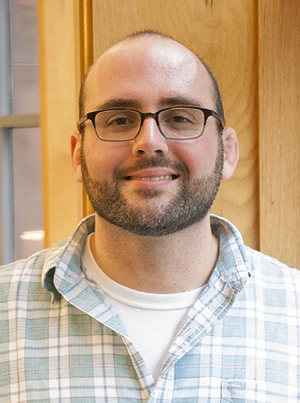By Corbin Black
Posted: April 13, 2018
 Dr. Michael Kearse is a postdoctoral fellow with Dr. Jeremy Wilusz in the Dept of Biochemistry and Biophysics at the University of Pennsylvania and a recent awardee of a K99/R00 Pathway to Independence grant from the US National Institutes of Health. Dr. Kearse completed his undergraduate work at Pennsylvania State University, and then joined the lab of Dr. Vassie Ware at Lehigh University for his doctoral studies, where he published a number of studies and earned several awards including a grant from the National Academy of Science. While initiating post-doctoral training at the University of Michigan (under the mentorship of Dr. Peter Todd and Dr. Aaron Goldstrohm), personal circumstances led Dr. Kearse last year to relocate to U. Penn and the Wilusz lab, where he continues to investigate regulation of non-AUG translation and its role in human biology and disease. “Canonical eukaryotic translation utilizes the universal AUG start codon for initiation,” he explained, “But evidence for initiation at non-AUG codon (i.e. CUG, GUG) has existed since the 1980s. Although non-AUG translation occurs with less efficiency than canonical translation, it is now clear that when dysregulated, non-AUG translation can directly contribute to human cancer and neurodegenerative disease.”
Dr. Michael Kearse is a postdoctoral fellow with Dr. Jeremy Wilusz in the Dept of Biochemistry and Biophysics at the University of Pennsylvania and a recent awardee of a K99/R00 Pathway to Independence grant from the US National Institutes of Health. Dr. Kearse completed his undergraduate work at Pennsylvania State University, and then joined the lab of Dr. Vassie Ware at Lehigh University for his doctoral studies, where he published a number of studies and earned several awards including a grant from the National Academy of Science. While initiating post-doctoral training at the University of Michigan (under the mentorship of Dr. Peter Todd and Dr. Aaron Goldstrohm), personal circumstances led Dr. Kearse last year to relocate to U. Penn and the Wilusz lab, where he continues to investigate regulation of non-AUG translation and its role in human biology and disease. “Canonical eukaryotic translation utilizes the universal AUG start codon for initiation,” he explained, “But evidence for initiation at non-AUG codon (i.e. CUG, GUG) has existed since the 1980s. Although non-AUG translation occurs with less efficiency than canonical translation, it is now clear that when dysregulated, non-AUG translation can directly contribute to human cancer and neurodegenerative disease.”
“Having to switch labs in mid-postdoc so suddenly was not something I was planning.”
Moving during his post-doc (for career opportunities for his wife) was a big challenge, and, at the time, he worried about what it would mean for his research, K99 application, and his job prospects. “Having to switch labs in mid-postdoc so suddenly was not something I was planning,” he said. “I’ve been very lucky to end up working with Jeremy. He has been very generous in many ways. From day one, Jeremy has let me develop my own research project that I can take with me when I establish my own lab next year.”
As someone who has had multiple mentors, Dr. Kearse knows how to choose the right training environment. He said, “It’s best to pick a position that is equally balanced between an environment that will motivate (not belittle) you, and one that pushes you intellectually to where you may be a little uncomfortable. This will be quite clear when meeting other trainees from the lab, and when looking at their past trainees (for established PIs) or their own career path (for younger PIs)—and then determine if it the lab aligns with your goals.” When looking for post-doctoral training opportunities, he warned, “When contacting potential mentors, avoid having a ‘one-size fits all’ cover letter. Instead, clearly state three reasons why you want to join their lab and describe an initial project.”
Dr. Kearse finds inspiration in conferences—“seeing good science excites me and makes me want to get back to the bench.” It’s also at meetings where he can “talk with and get insight from leaders in the field.” His favorite conference memory is the career panel at 2015 Annual RNA Society Meeting (Madison, WI) where several established PIs spoke candidly as they related their own the uncertainty, the rejections, and tough times at the lab bench. Dr. Kearse reflected, “This left a lasting impression on me knowing that we all have to push through the same road blocks.”
As for scientific advice, Dr. Kearse suggested that, above all, “Follow the phenotype!” and added that “some of the biggest advancements in RNA biology (e.g. RNAi, catalytic RNAs, CRISPR) were discovered by researchers following the phenotype. If an experiment is well controlled, an unexpected and novel result can be the beginning of an incredible research project or field.”
Dr. Kearse doesn’t use social media so you’ll have to come to the next RNA Society Meeting (in May in Berkeley, California) if you want to find out why his favorite RNAs are FMR1 mRNA and ribosomal RNA! If you can’t make it to sunny California but want to get an insider’s view on writing a successful K99/R00 application, don’t hesitate to contact Mike directly.
